Customer Experience Report: Analyzing Lipton Tea's Market and Strategy
VerifiedAdded on 2022/12/12
|9
|3303
|354
Report
AI Summary
This report provides a comprehensive analysis of Lipton tea's customer experience, examining its market position, key customer demographics, and relevant customer attitudes. The report utilizes the Boston Matrix to assess Lipton's strategic business units, and it identifies market segmentation strategies based on geographic, demographic, psychographic, and behavioral factors. It explores the attitudes of customers towards the brand and customer service, including the impact of growing household incomes and consumer awareness. The report further analyzes Lipton's brand statements and conducts a brand audit, evaluating both internal and external branding aspects. It critically assesses these elements against customer experience models and theories, offering strategic recommendations to improve customer experience and address digital disruption, ultimately aiming to benefit both the customers and the organization. The report also covers aspects like product positioning, pricing, distribution, and promotional strategies.
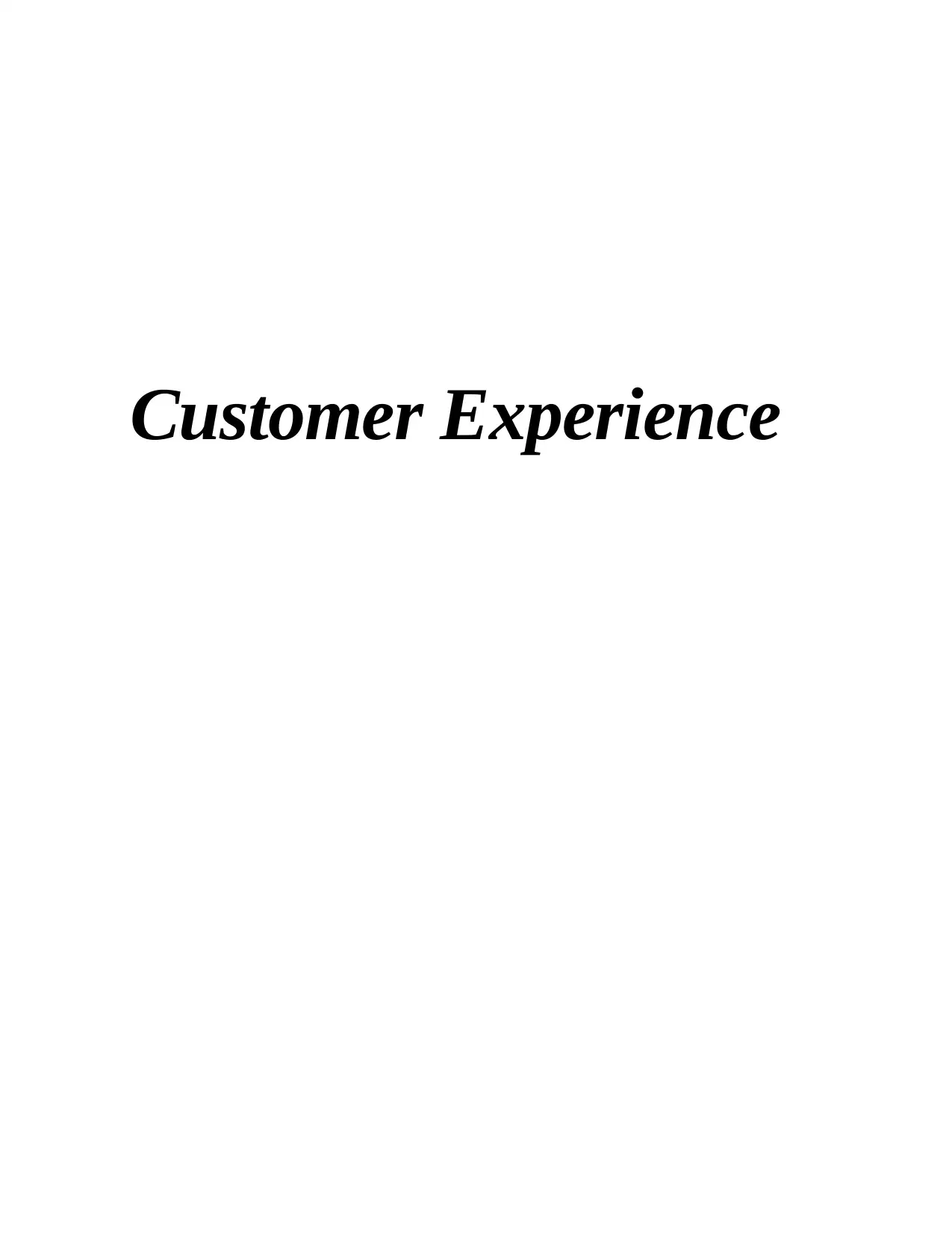
Customer Experience
Paraphrase This Document
Need a fresh take? Get an instant paraphrase of this document with our AI Paraphraser
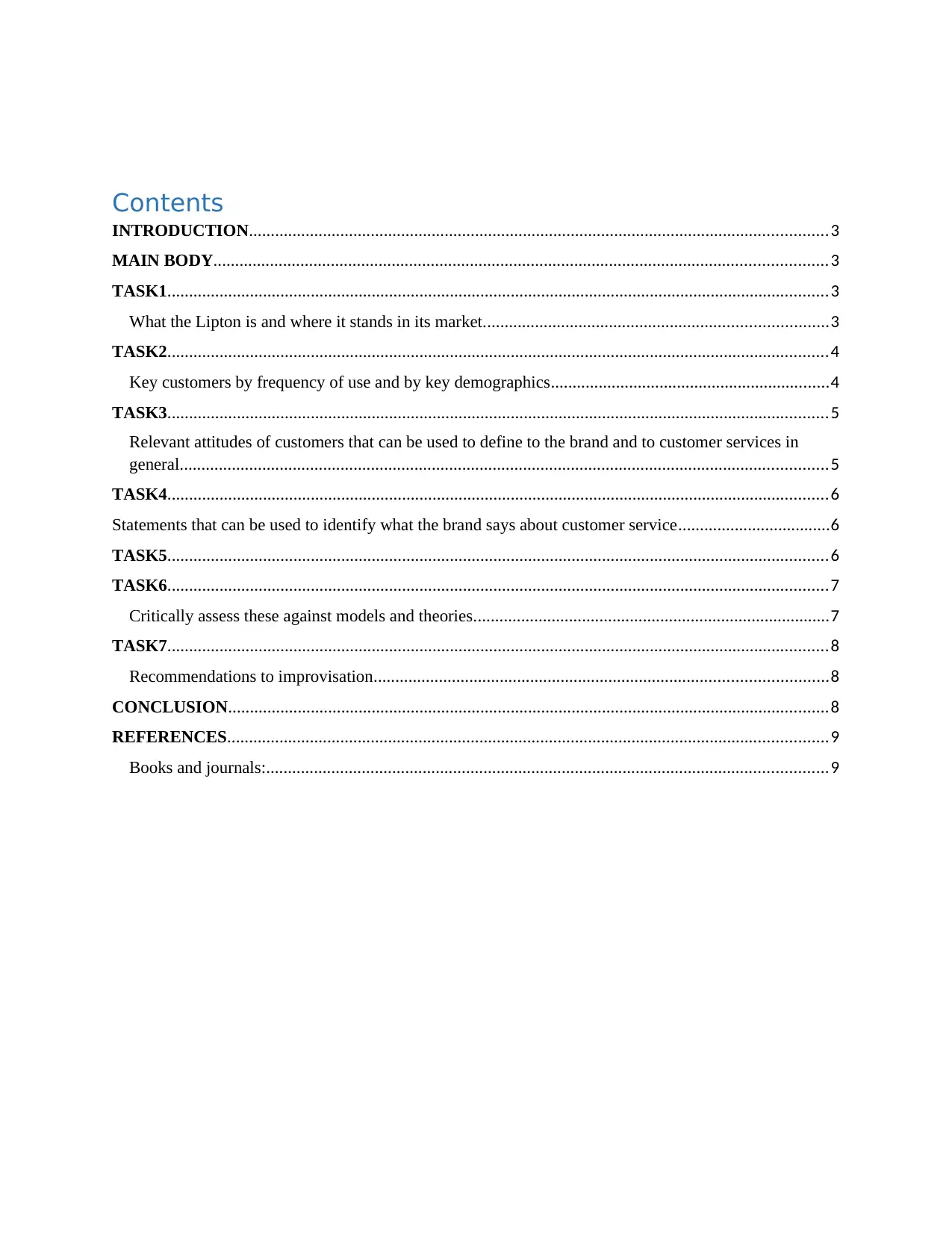
Contents
INTRODUCTION.....................................................................................................................................3
MAIN BODY.............................................................................................................................................3
TASK1........................................................................................................................................................3
What the Lipton is and where it stands in its market...............................................................................3
TASK2........................................................................................................................................................4
Key customers by frequency of use and by key demographics................................................................4
TASK3........................................................................................................................................................5
Relevant attitudes of customers that can be used to define to the brand and to customer services in
general.....................................................................................................................................................5
TASK4........................................................................................................................................................6
Statements that can be used to identify what the brand says about customer service...................................6
TASK5........................................................................................................................................................6
TASK6........................................................................................................................................................7
Critically assess these against models and theories..................................................................................7
TASK7........................................................................................................................................................8
Recommendations to improvisation........................................................................................................8
CONCLUSION..........................................................................................................................................8
REFERENCES..........................................................................................................................................9
Books and journals:.................................................................................................................................9
INTRODUCTION.....................................................................................................................................3
MAIN BODY.............................................................................................................................................3
TASK1........................................................................................................................................................3
What the Lipton is and where it stands in its market...............................................................................3
TASK2........................................................................................................................................................4
Key customers by frequency of use and by key demographics................................................................4
TASK3........................................................................................................................................................5
Relevant attitudes of customers that can be used to define to the brand and to customer services in
general.....................................................................................................................................................5
TASK4........................................................................................................................................................6
Statements that can be used to identify what the brand says about customer service...................................6
TASK5........................................................................................................................................................6
TASK6........................................................................................................................................................7
Critically assess these against models and theories..................................................................................7
TASK7........................................................................................................................................................8
Recommendations to improvisation........................................................................................................8
CONCLUSION..........................................................................................................................................8
REFERENCES..........................................................................................................................................9
Books and journals:.................................................................................................................................9
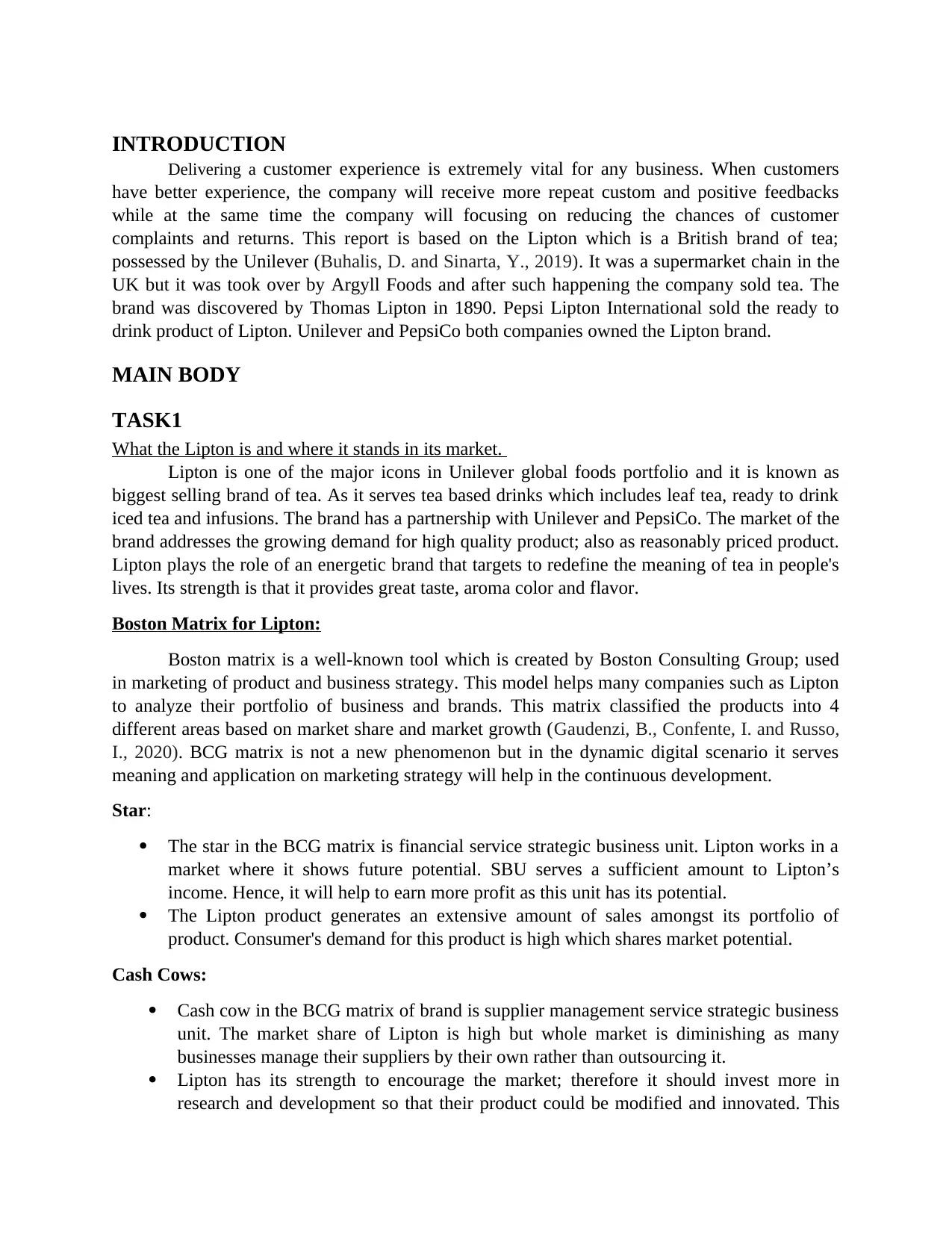
INTRODUCTION
Delivering a customer experience is extremely vital for any business. When customers
have better experience, the company will receive more repeat custom and positive feedbacks
while at the same time the company will focusing on reducing the chances of customer
complaints and returns. This report is based on the Lipton which is a British brand of tea;
possessed by the Unilever (Buhalis, D. and Sinarta, Y., 2019). It was a supermarket chain in the
UK but it was took over by Argyll Foods and after such happening the company sold tea. The
brand was discovered by Thomas Lipton in 1890. Pepsi Lipton International sold the ready to
drink product of Lipton. Unilever and PepsiCo both companies owned the Lipton brand.
MAIN BODY
TASK1
What the Lipton is and where it stands in its market.
Lipton is one of the major icons in Unilever global foods portfolio and it is known as
biggest selling brand of tea. As it serves tea based drinks which includes leaf tea, ready to drink
iced tea and infusions. The brand has a partnership with Unilever and PepsiCo. The market of the
brand addresses the growing demand for high quality product; also as reasonably priced product.
Lipton plays the role of an energetic brand that targets to redefine the meaning of tea in people's
lives. Its strength is that it provides great taste, aroma color and flavor.
Boston Matrix for Lipton:
Boston matrix is a well-known tool which is created by Boston Consulting Group; used
in marketing of product and business strategy. This model helps many companies such as Lipton
to analyze their portfolio of business and brands. This matrix classified the products into 4
different areas based on market share and market growth (Gaudenzi, B., Confente, I. and Russo,
I., 2020). BCG matrix is not a new phenomenon but in the dynamic digital scenario it serves
meaning and application on marketing strategy will help in the continuous development.
Star:
The star in the BCG matrix is financial service strategic business unit. Lipton works in a
market where it shows future potential. SBU serves a sufficient amount to Lipton’s
income. Hence, it will help to earn more profit as this unit has its potential.
The Lipton product generates an extensive amount of sales amongst its portfolio of
product. Consumer's demand for this product is high which shares market potential.
Cash Cows:
Cash cow in the BCG matrix of brand is supplier management service strategic business
unit. The market share of Lipton is high but whole market is diminishing as many
businesses manage their suppliers by their own rather than outsourcing it.
Lipton has its strength to encourage the market; therefore it should invest more in
research and development so that their product could be modified and innovated. This
Delivering a customer experience is extremely vital for any business. When customers
have better experience, the company will receive more repeat custom and positive feedbacks
while at the same time the company will focusing on reducing the chances of customer
complaints and returns. This report is based on the Lipton which is a British brand of tea;
possessed by the Unilever (Buhalis, D. and Sinarta, Y., 2019). It was a supermarket chain in the
UK but it was took over by Argyll Foods and after such happening the company sold tea. The
brand was discovered by Thomas Lipton in 1890. Pepsi Lipton International sold the ready to
drink product of Lipton. Unilever and PepsiCo both companies owned the Lipton brand.
MAIN BODY
TASK1
What the Lipton is and where it stands in its market.
Lipton is one of the major icons in Unilever global foods portfolio and it is known as
biggest selling brand of tea. As it serves tea based drinks which includes leaf tea, ready to drink
iced tea and infusions. The brand has a partnership with Unilever and PepsiCo. The market of the
brand addresses the growing demand for high quality product; also as reasonably priced product.
Lipton plays the role of an energetic brand that targets to redefine the meaning of tea in people's
lives. Its strength is that it provides great taste, aroma color and flavor.
Boston Matrix for Lipton:
Boston matrix is a well-known tool which is created by Boston Consulting Group; used
in marketing of product and business strategy. This model helps many companies such as Lipton
to analyze their portfolio of business and brands. This matrix classified the products into 4
different areas based on market share and market growth (Gaudenzi, B., Confente, I. and Russo,
I., 2020). BCG matrix is not a new phenomenon but in the dynamic digital scenario it serves
meaning and application on marketing strategy will help in the continuous development.
Star:
The star in the BCG matrix is financial service strategic business unit. Lipton works in a
market where it shows future potential. SBU serves a sufficient amount to Lipton’s
income. Hence, it will help to earn more profit as this unit has its potential.
The Lipton product generates an extensive amount of sales amongst its portfolio of
product. Consumer's demand for this product is high which shares market potential.
Cash Cows:
Cash cow in the BCG matrix of brand is supplier management service strategic business
unit. The market share of Lipton is high but whole market is diminishing as many
businesses manage their suppliers by their own rather than outsourcing it.
Lipton has its strength to encourage the market; therefore it should invest more in
research and development so that their product could be modified and innovated. This
⊘ This is a preview!⊘
Do you want full access?
Subscribe today to unlock all pages.

Trusted by 1+ million students worldwide
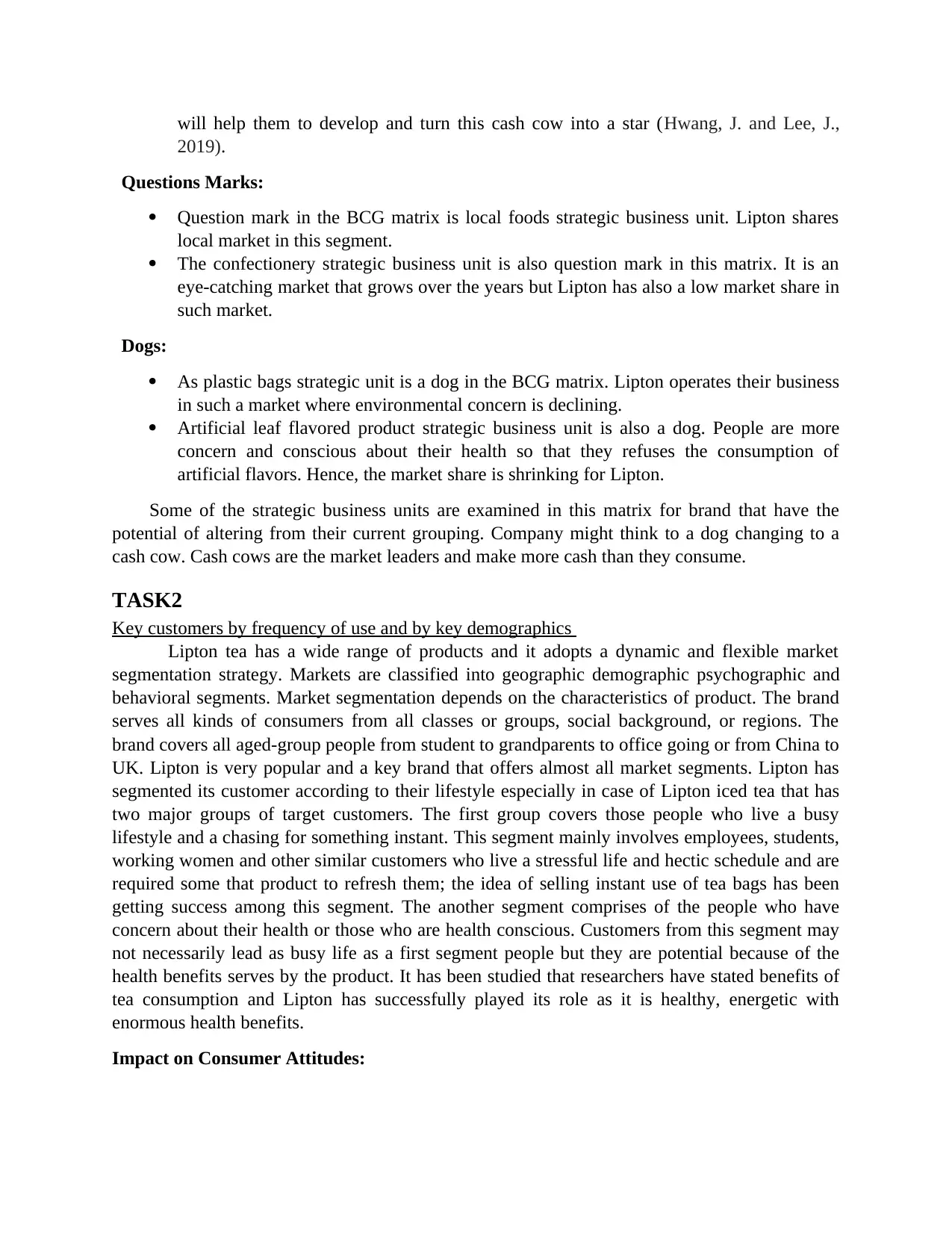
will help them to develop and turn this cash cow into a star (Hwang, J. and Lee, J.,
2019).
Questions Marks:
Question mark in the BCG matrix is local foods strategic business unit. Lipton shares
local market in this segment.
The confectionery strategic business unit is also question mark in this matrix. It is an
eye-catching market that grows over the years but Lipton has also a low market share in
such market.
Dogs:
As plastic bags strategic unit is a dog in the BCG matrix. Lipton operates their business
in such a market where environmental concern is declining.
Artificial leaf flavored product strategic business unit is also a dog. People are more
concern and conscious about their health so that they refuses the consumption of
artificial flavors. Hence, the market share is shrinking for Lipton.
Some of the strategic business units are examined in this matrix for brand that have the
potential of altering from their current grouping. Company might think to a dog changing to a
cash cow. Cash cows are the market leaders and make more cash than they consume.
TASK2
Key customers by frequency of use and by key demographics
Lipton tea has a wide range of products and it adopts a dynamic and flexible market
segmentation strategy. Markets are classified into geographic demographic psychographic and
behavioral segments. Market segmentation depends on the characteristics of product. The brand
serves all kinds of consumers from all classes or groups, social background, or regions. The
brand covers all aged-group people from student to grandparents to office going or from China to
UK. Lipton is very popular and a key brand that offers almost all market segments. Lipton has
segmented its customer according to their lifestyle especially in case of Lipton iced tea that has
two major groups of target customers. The first group covers those people who live a busy
lifestyle and a chasing for something instant. This segment mainly involves employees, students,
working women and other similar customers who live a stressful life and hectic schedule and are
required some that product to refresh them; the idea of selling instant use of tea bags has been
getting success among this segment. The another segment comprises of the people who have
concern about their health or those who are health conscious. Customers from this segment may
not necessarily lead as busy life as a first segment people but they are potential because of the
health benefits serves by the product. It has been studied that researchers have stated benefits of
tea consumption and Lipton has successfully played its role as it is healthy, energetic with
enormous health benefits.
Impact on Consumer Attitudes:
2019).
Questions Marks:
Question mark in the BCG matrix is local foods strategic business unit. Lipton shares
local market in this segment.
The confectionery strategic business unit is also question mark in this matrix. It is an
eye-catching market that grows over the years but Lipton has also a low market share in
such market.
Dogs:
As plastic bags strategic unit is a dog in the BCG matrix. Lipton operates their business
in such a market where environmental concern is declining.
Artificial leaf flavored product strategic business unit is also a dog. People are more
concern and conscious about their health so that they refuses the consumption of
artificial flavors. Hence, the market share is shrinking for Lipton.
Some of the strategic business units are examined in this matrix for brand that have the
potential of altering from their current grouping. Company might think to a dog changing to a
cash cow. Cash cows are the market leaders and make more cash than they consume.
TASK2
Key customers by frequency of use and by key demographics
Lipton tea has a wide range of products and it adopts a dynamic and flexible market
segmentation strategy. Markets are classified into geographic demographic psychographic and
behavioral segments. Market segmentation depends on the characteristics of product. The brand
serves all kinds of consumers from all classes or groups, social background, or regions. The
brand covers all aged-group people from student to grandparents to office going or from China to
UK. Lipton is very popular and a key brand that offers almost all market segments. Lipton has
segmented its customer according to their lifestyle especially in case of Lipton iced tea that has
two major groups of target customers. The first group covers those people who live a busy
lifestyle and a chasing for something instant. This segment mainly involves employees, students,
working women and other similar customers who live a stressful life and hectic schedule and are
required some that product to refresh them; the idea of selling instant use of tea bags has been
getting success among this segment. The another segment comprises of the people who have
concern about their health or those who are health conscious. Customers from this segment may
not necessarily lead as busy life as a first segment people but they are potential because of the
health benefits serves by the product. It has been studied that researchers have stated benefits of
tea consumption and Lipton has successfully played its role as it is healthy, energetic with
enormous health benefits.
Impact on Consumer Attitudes:
Paraphrase This Document
Need a fresh take? Get an instant paraphrase of this document with our AI Paraphraser
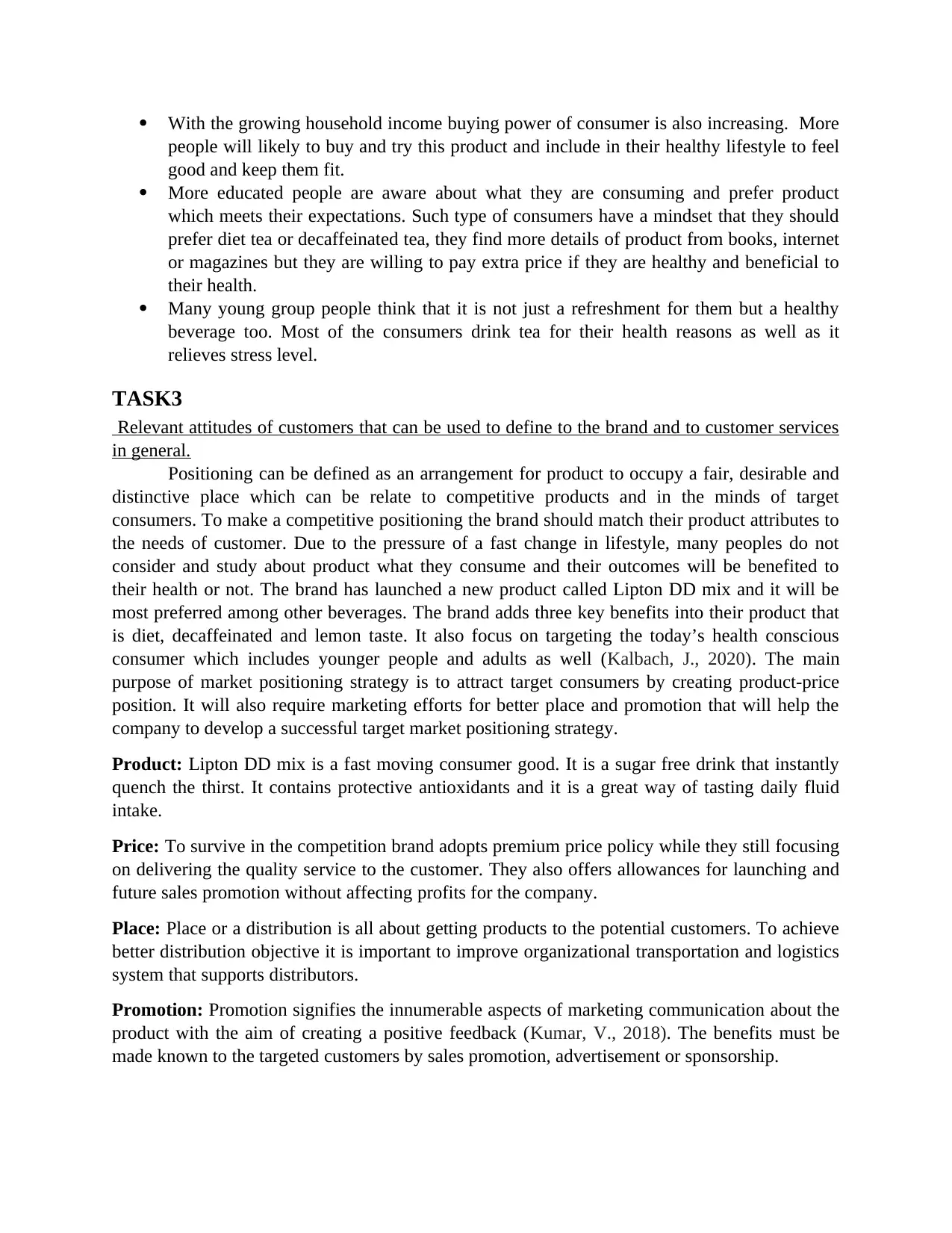
With the growing household income buying power of consumer is also increasing. More
people will likely to buy and try this product and include in their healthy lifestyle to feel
good and keep them fit.
More educated people are aware about what they are consuming and prefer product
which meets their expectations. Such type of consumers have a mindset that they should
prefer diet tea or decaffeinated tea, they find more details of product from books, internet
or magazines but they are willing to pay extra price if they are healthy and beneficial to
their health.
Many young group people think that it is not just a refreshment for them but a healthy
beverage too. Most of the consumers drink tea for their health reasons as well as it
relieves stress level.
TASK3
Relevant attitudes of customers that can be used to define to the brand and to customer services
in general.
Positioning can be defined as an arrangement for product to occupy a fair, desirable and
distinctive place which can be relate to competitive products and in the minds of target
consumers. To make a competitive positioning the brand should match their product attributes to
the needs of customer. Due to the pressure of a fast change in lifestyle, many peoples do not
consider and study about product what they consume and their outcomes will be benefited to
their health or not. The brand has launched a new product called Lipton DD mix and it will be
most preferred among other beverages. The brand adds three key benefits into their product that
is diet, decaffeinated and lemon taste. It also focus on targeting the today’s health conscious
consumer which includes younger people and adults as well (Kalbach, J., 2020). The main
purpose of market positioning strategy is to attract target consumers by creating product-price
position. It will also require marketing efforts for better place and promotion that will help the
company to develop a successful target market positioning strategy.
Product: Lipton DD mix is a fast moving consumer good. It is a sugar free drink that instantly
quench the thirst. It contains protective antioxidants and it is a great way of tasting daily fluid
intake.
Price: To survive in the competition brand adopts premium price policy while they still focusing
on delivering the quality service to the customer. They also offers allowances for launching and
future sales promotion without affecting profits for the company.
Place: Place or a distribution is all about getting products to the potential customers. To achieve
better distribution objective it is important to improve organizational transportation and logistics
system that supports distributors.
Promotion: Promotion signifies the innumerable aspects of marketing communication about the
product with the aim of creating a positive feedback (Kumar, V., 2018). The benefits must be
made known to the targeted customers by sales promotion, advertisement or sponsorship.
people will likely to buy and try this product and include in their healthy lifestyle to feel
good and keep them fit.
More educated people are aware about what they are consuming and prefer product
which meets their expectations. Such type of consumers have a mindset that they should
prefer diet tea or decaffeinated tea, they find more details of product from books, internet
or magazines but they are willing to pay extra price if they are healthy and beneficial to
their health.
Many young group people think that it is not just a refreshment for them but a healthy
beverage too. Most of the consumers drink tea for their health reasons as well as it
relieves stress level.
TASK3
Relevant attitudes of customers that can be used to define to the brand and to customer services
in general.
Positioning can be defined as an arrangement for product to occupy a fair, desirable and
distinctive place which can be relate to competitive products and in the minds of target
consumers. To make a competitive positioning the brand should match their product attributes to
the needs of customer. Due to the pressure of a fast change in lifestyle, many peoples do not
consider and study about product what they consume and their outcomes will be benefited to
their health or not. The brand has launched a new product called Lipton DD mix and it will be
most preferred among other beverages. The brand adds three key benefits into their product that
is diet, decaffeinated and lemon taste. It also focus on targeting the today’s health conscious
consumer which includes younger people and adults as well (Kalbach, J., 2020). The main
purpose of market positioning strategy is to attract target consumers by creating product-price
position. It will also require marketing efforts for better place and promotion that will help the
company to develop a successful target market positioning strategy.
Product: Lipton DD mix is a fast moving consumer good. It is a sugar free drink that instantly
quench the thirst. It contains protective antioxidants and it is a great way of tasting daily fluid
intake.
Price: To survive in the competition brand adopts premium price policy while they still focusing
on delivering the quality service to the customer. They also offers allowances for launching and
future sales promotion without affecting profits for the company.
Place: Place or a distribution is all about getting products to the potential customers. To achieve
better distribution objective it is important to improve organizational transportation and logistics
system that supports distributors.
Promotion: Promotion signifies the innumerable aspects of marketing communication about the
product with the aim of creating a positive feedback (Kumar, V., 2018). The benefits must be
made known to the targeted customers by sales promotion, advertisement or sponsorship.
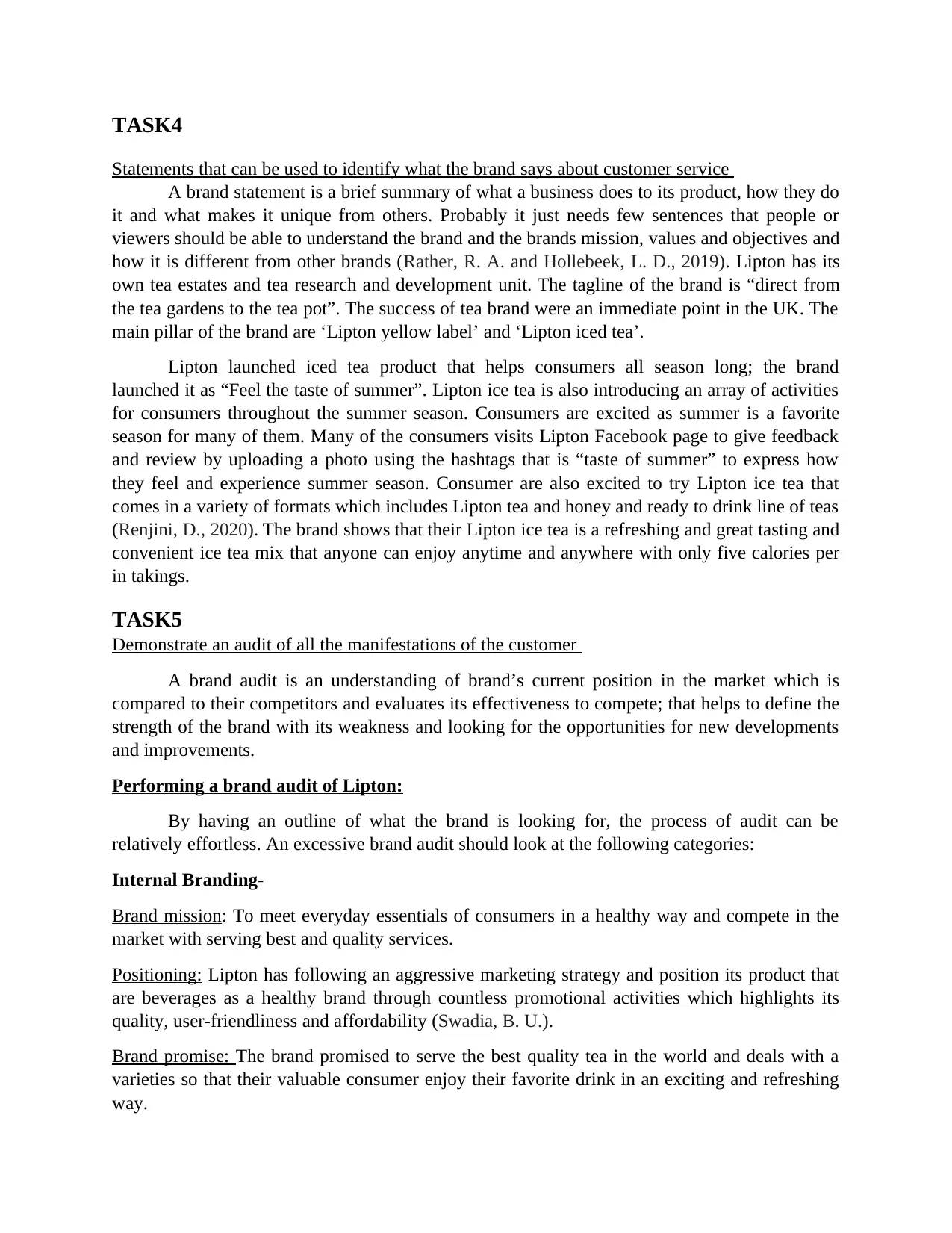
TASK4
Statements that can be used to identify what the brand says about customer service
A brand statement is a brief summary of what a business does to its product, how they do
it and what makes it unique from others. Probably it just needs few sentences that people or
viewers should be able to understand the brand and the brands mission, values and objectives and
how it is different from other brands (Rather, R. A. and Hollebeek, L. D., 2019). Lipton has its
own tea estates and tea research and development unit. The tagline of the brand is “direct from
the tea gardens to the tea pot”. The success of tea brand were an immediate point in the UK. The
main pillar of the brand are ‘Lipton yellow label’ and ‘Lipton iced tea’.
Lipton launched iced tea product that helps consumers all season long; the brand
launched it as “Feel the taste of summer”. Lipton ice tea is also introducing an array of activities
for consumers throughout the summer season. Consumers are excited as summer is a favorite
season for many of them. Many of the consumers visits Lipton Facebook page to give feedback
and review by uploading a photo using the hashtags that is “taste of summer” to express how
they feel and experience summer season. Consumer are also excited to try Lipton ice tea that
comes in a variety of formats which includes Lipton tea and honey and ready to drink line of teas
(Renjini, D., 2020). The brand shows that their Lipton ice tea is a refreshing and great tasting and
convenient ice tea mix that anyone can enjoy anytime and anywhere with only five calories per
in takings.
TASK5
Demonstrate an audit of all the manifestations of the customer
A brand audit is an understanding of brand’s current position in the market which is
compared to their competitors and evaluates its effectiveness to compete; that helps to define the
strength of the brand with its weakness and looking for the opportunities for new developments
and improvements.
Performing a brand audit of Lipton:
By having an outline of what the brand is looking for, the process of audit can be
relatively effortless. An excessive brand audit should look at the following categories:
Internal Branding-
Brand mission: To meet everyday essentials of consumers in a healthy way and compete in the
market with serving best and quality services.
Positioning: Lipton has following an aggressive marketing strategy and position its product that
are beverages as a healthy brand through countless promotional activities which highlights its
quality, user-friendliness and affordability (Swadia, B. U.).
Brand promise: The brand promised to serve the best quality tea in the world and deals with a
varieties so that their valuable consumer enjoy their favorite drink in an exciting and refreshing
way.
Statements that can be used to identify what the brand says about customer service
A brand statement is a brief summary of what a business does to its product, how they do
it and what makes it unique from others. Probably it just needs few sentences that people or
viewers should be able to understand the brand and the brands mission, values and objectives and
how it is different from other brands (Rather, R. A. and Hollebeek, L. D., 2019). Lipton has its
own tea estates and tea research and development unit. The tagline of the brand is “direct from
the tea gardens to the tea pot”. The success of tea brand were an immediate point in the UK. The
main pillar of the brand are ‘Lipton yellow label’ and ‘Lipton iced tea’.
Lipton launched iced tea product that helps consumers all season long; the brand
launched it as “Feel the taste of summer”. Lipton ice tea is also introducing an array of activities
for consumers throughout the summer season. Consumers are excited as summer is a favorite
season for many of them. Many of the consumers visits Lipton Facebook page to give feedback
and review by uploading a photo using the hashtags that is “taste of summer” to express how
they feel and experience summer season. Consumer are also excited to try Lipton ice tea that
comes in a variety of formats which includes Lipton tea and honey and ready to drink line of teas
(Renjini, D., 2020). The brand shows that their Lipton ice tea is a refreshing and great tasting and
convenient ice tea mix that anyone can enjoy anytime and anywhere with only five calories per
in takings.
TASK5
Demonstrate an audit of all the manifestations of the customer
A brand audit is an understanding of brand’s current position in the market which is
compared to their competitors and evaluates its effectiveness to compete; that helps to define the
strength of the brand with its weakness and looking for the opportunities for new developments
and improvements.
Performing a brand audit of Lipton:
By having an outline of what the brand is looking for, the process of audit can be
relatively effortless. An excessive brand audit should look at the following categories:
Internal Branding-
Brand mission: To meet everyday essentials of consumers in a healthy way and compete in the
market with serving best and quality services.
Positioning: Lipton has following an aggressive marketing strategy and position its product that
are beverages as a healthy brand through countless promotional activities which highlights its
quality, user-friendliness and affordability (Swadia, B. U.).
Brand promise: The brand promised to serve the best quality tea in the world and deals with a
varieties so that their valuable consumer enjoy their favorite drink in an exciting and refreshing
way.
⊘ This is a preview!⊘
Do you want full access?
Subscribe today to unlock all pages.

Trusted by 1+ million students worldwide
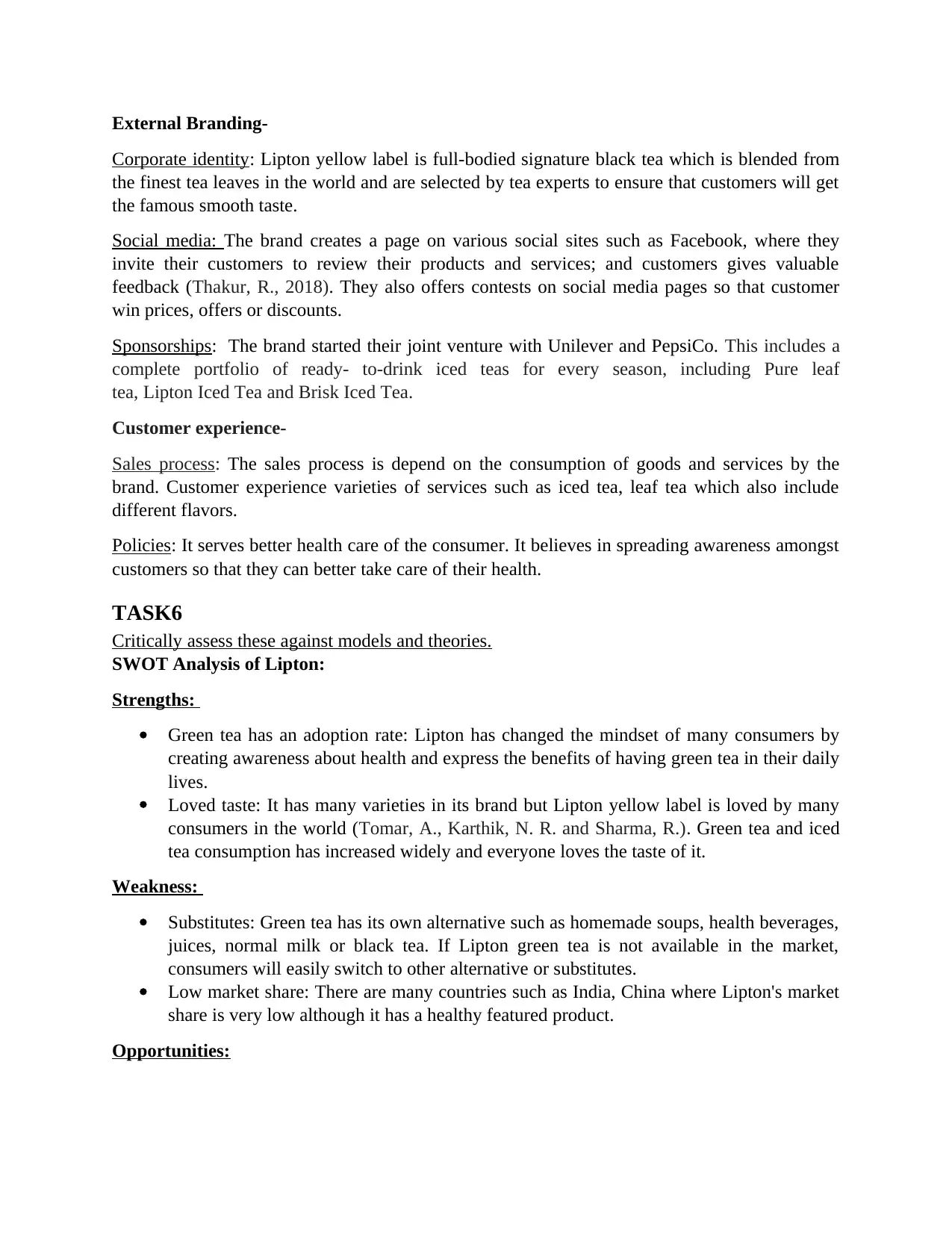
External Branding-
Corporate identity: Lipton yellow label is full-bodied signature black tea which is blended from
the finest tea leaves in the world and are selected by tea experts to ensure that customers will get
the famous smooth taste.
Social media: The brand creates a page on various social sites such as Facebook, where they
invite their customers to review their products and services; and customers gives valuable
feedback (Thakur, R., 2018). They also offers contests on social media pages so that customer
win prices, offers or discounts.
Sponsorships: The brand started their joint venture with Unilever and PepsiCo. This includes a
complete portfolio of ready- to-drink iced teas for every season, including Pure leaf
tea, Lipton Iced Tea and Brisk Iced Tea.
Customer experience-
Sales process: The sales process is depend on the consumption of goods and services by the
brand. Customer experience varieties of services such as iced tea, leaf tea which also include
different flavors.
Policies: It serves better health care of the consumer. It believes in spreading awareness amongst
customers so that they can better take care of their health.
TASK6
Critically assess these against models and theories.
SWOT Analysis of Lipton:
Strengths:
Green tea has an adoption rate: Lipton has changed the mindset of many consumers by
creating awareness about health and express the benefits of having green tea in their daily
lives.
Loved taste: It has many varieties in its brand but Lipton yellow label is loved by many
consumers in the world (Tomar, A., Karthik, N. R. and Sharma, R.). Green tea and iced
tea consumption has increased widely and everyone loves the taste of it.
Weakness:
Substitutes: Green tea has its own alternative such as homemade soups, health beverages,
juices, normal milk or black tea. If Lipton green tea is not available in the market,
consumers will easily switch to other alternative or substitutes.
Low market share: There are many countries such as India, China where Lipton's market
share is very low although it has a healthy featured product.
Opportunities:
Corporate identity: Lipton yellow label is full-bodied signature black tea which is blended from
the finest tea leaves in the world and are selected by tea experts to ensure that customers will get
the famous smooth taste.
Social media: The brand creates a page on various social sites such as Facebook, where they
invite their customers to review their products and services; and customers gives valuable
feedback (Thakur, R., 2018). They also offers contests on social media pages so that customer
win prices, offers or discounts.
Sponsorships: The brand started their joint venture with Unilever and PepsiCo. This includes a
complete portfolio of ready- to-drink iced teas for every season, including Pure leaf
tea, Lipton Iced Tea and Brisk Iced Tea.
Customer experience-
Sales process: The sales process is depend on the consumption of goods and services by the
brand. Customer experience varieties of services such as iced tea, leaf tea which also include
different flavors.
Policies: It serves better health care of the consumer. It believes in spreading awareness amongst
customers so that they can better take care of their health.
TASK6
Critically assess these against models and theories.
SWOT Analysis of Lipton:
Strengths:
Green tea has an adoption rate: Lipton has changed the mindset of many consumers by
creating awareness about health and express the benefits of having green tea in their daily
lives.
Loved taste: It has many varieties in its brand but Lipton yellow label is loved by many
consumers in the world (Tomar, A., Karthik, N. R. and Sharma, R.). Green tea and iced
tea consumption has increased widely and everyone loves the taste of it.
Weakness:
Substitutes: Green tea has its own alternative such as homemade soups, health beverages,
juices, normal milk or black tea. If Lipton green tea is not available in the market,
consumers will easily switch to other alternative or substitutes.
Low market share: There are many countries such as India, China where Lipton's market
share is very low although it has a healthy featured product.
Opportunities:
Paraphrase This Document
Need a fresh take? Get an instant paraphrase of this document with our AI Paraphraser
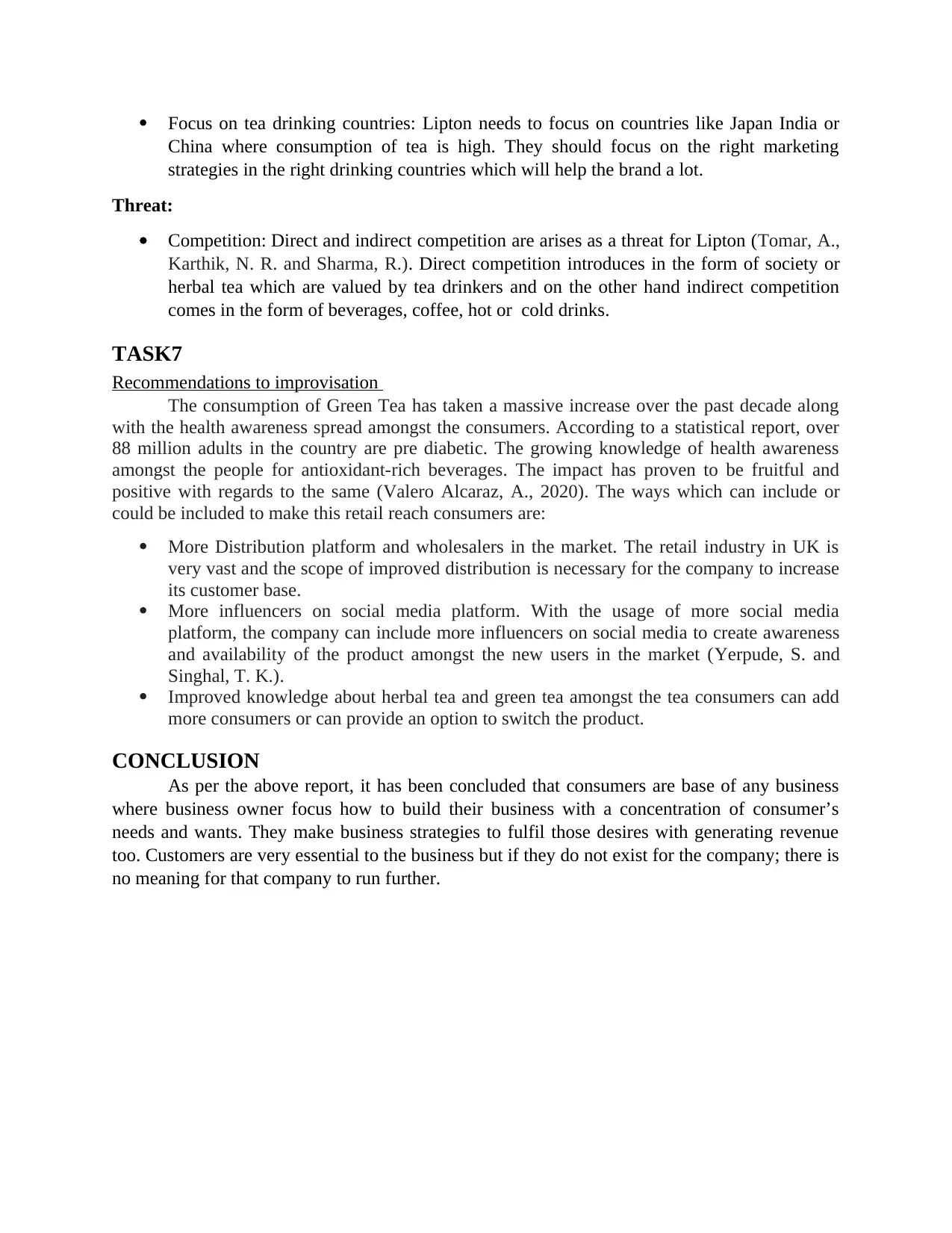
Focus on tea drinking countries: Lipton needs to focus on countries like Japan India or
China where consumption of tea is high. They should focus on the right marketing
strategies in the right drinking countries which will help the brand a lot.
Threat:
Competition: Direct and indirect competition are arises as a threat for Lipton (Tomar, A.,
Karthik, N. R. and Sharma, R.). Direct competition introduces in the form of society or
herbal tea which are valued by tea drinkers and on the other hand indirect competition
comes in the form of beverages, coffee, hot or cold drinks.
TASK7
Recommendations to improvisation
The consumption of Green Tea has taken a massive increase over the past decade along
with the health awareness spread amongst the consumers. According to a statistical report, over
88 million adults in the country are pre diabetic. The growing knowledge of health awareness
amongst the people for antioxidant-rich beverages. The impact has proven to be fruitful and
positive with regards to the same (Valero Alcaraz, A., 2020). The ways which can include or
could be included to make this retail reach consumers are:
More Distribution platform and wholesalers in the market. The retail industry in UK is
very vast and the scope of improved distribution is necessary for the company to increase
its customer base.
More influencers on social media platform. With the usage of more social media
platform, the company can include more influencers on social media to create awareness
and availability of the product amongst the new users in the market (Yerpude, S. and
Singhal, T. K.).
Improved knowledge about herbal tea and green tea amongst the tea consumers can add
more consumers or can provide an option to switch the product.
CONCLUSION
As per the above report, it has been concluded that consumers are base of any business
where business owner focus how to build their business with a concentration of consumer’s
needs and wants. They make business strategies to fulfil those desires with generating revenue
too. Customers are very essential to the business but if they do not exist for the company; there is
no meaning for that company to run further.
China where consumption of tea is high. They should focus on the right marketing
strategies in the right drinking countries which will help the brand a lot.
Threat:
Competition: Direct and indirect competition are arises as a threat for Lipton (Tomar, A.,
Karthik, N. R. and Sharma, R.). Direct competition introduces in the form of society or
herbal tea which are valued by tea drinkers and on the other hand indirect competition
comes in the form of beverages, coffee, hot or cold drinks.
TASK7
Recommendations to improvisation
The consumption of Green Tea has taken a massive increase over the past decade along
with the health awareness spread amongst the consumers. According to a statistical report, over
88 million adults in the country are pre diabetic. The growing knowledge of health awareness
amongst the people for antioxidant-rich beverages. The impact has proven to be fruitful and
positive with regards to the same (Valero Alcaraz, A., 2020). The ways which can include or
could be included to make this retail reach consumers are:
More Distribution platform and wholesalers in the market. The retail industry in UK is
very vast and the scope of improved distribution is necessary for the company to increase
its customer base.
More influencers on social media platform. With the usage of more social media
platform, the company can include more influencers on social media to create awareness
and availability of the product amongst the new users in the market (Yerpude, S. and
Singhal, T. K.).
Improved knowledge about herbal tea and green tea amongst the tea consumers can add
more consumers or can provide an option to switch the product.
CONCLUSION
As per the above report, it has been concluded that consumers are base of any business
where business owner focus how to build their business with a concentration of consumer’s
needs and wants. They make business strategies to fulfil those desires with generating revenue
too. Customers are very essential to the business but if they do not exist for the company; there is
no meaning for that company to run further.
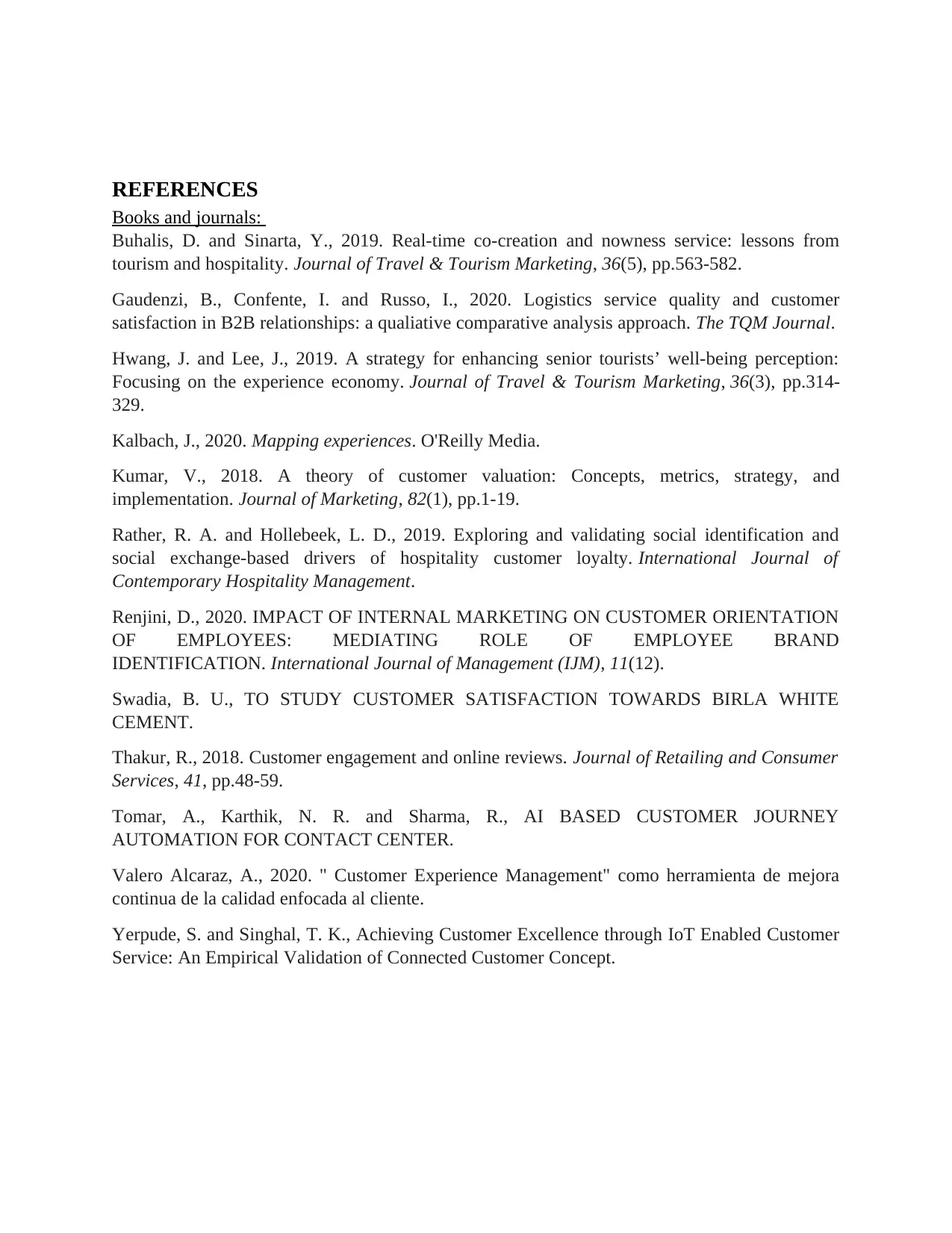
REFERENCES
Books and journals:
Buhalis, D. and Sinarta, Y., 2019. Real-time co-creation and nowness service: lessons from
tourism and hospitality. Journal of Travel & Tourism Marketing, 36(5), pp.563-582.
Gaudenzi, B., Confente, I. and Russo, I., 2020. Logistics service quality and customer
satisfaction in B2B relationships: a qualiative comparative analysis approach. The TQM Journal.
Hwang, J. and Lee, J., 2019. A strategy for enhancing senior tourists’ well-being perception:
Focusing on the experience economy. Journal of Travel & Tourism Marketing, 36(3), pp.314-
329.
Kalbach, J., 2020. Mapping experiences. O'Reilly Media.
Kumar, V., 2018. A theory of customer valuation: Concepts, metrics, strategy, and
implementation. Journal of Marketing, 82(1), pp.1-19.
Rather, R. A. and Hollebeek, L. D., 2019. Exploring and validating social identification and
social exchange-based drivers of hospitality customer loyalty. International Journal of
Contemporary Hospitality Management.
Renjini, D., 2020. IMPACT OF INTERNAL MARKETING ON CUSTOMER ORIENTATION
OF EMPLOYEES: MEDIATING ROLE OF EMPLOYEE BRAND
IDENTIFICATION. International Journal of Management (IJM), 11(12).
Swadia, B. U., TO STUDY CUSTOMER SATISFACTION TOWARDS BIRLA WHITE
CEMENT.
Thakur, R., 2018. Customer engagement and online reviews. Journal of Retailing and Consumer
Services, 41, pp.48-59.
Tomar, A., Karthik, N. R. and Sharma, R., AI BASED CUSTOMER JOURNEY
AUTOMATION FOR CONTACT CENTER.
Valero Alcaraz, A., 2020. " Customer Experience Management" como herramienta de mejora
continua de la calidad enfocada al cliente.
Yerpude, S. and Singhal, T. K., Achieving Customer Excellence through IoT Enabled Customer
Service: An Empirical Validation of Connected Customer Concept.
Books and journals:
Buhalis, D. and Sinarta, Y., 2019. Real-time co-creation and nowness service: lessons from
tourism and hospitality. Journal of Travel & Tourism Marketing, 36(5), pp.563-582.
Gaudenzi, B., Confente, I. and Russo, I., 2020. Logistics service quality and customer
satisfaction in B2B relationships: a qualiative comparative analysis approach. The TQM Journal.
Hwang, J. and Lee, J., 2019. A strategy for enhancing senior tourists’ well-being perception:
Focusing on the experience economy. Journal of Travel & Tourism Marketing, 36(3), pp.314-
329.
Kalbach, J., 2020. Mapping experiences. O'Reilly Media.
Kumar, V., 2018. A theory of customer valuation: Concepts, metrics, strategy, and
implementation. Journal of Marketing, 82(1), pp.1-19.
Rather, R. A. and Hollebeek, L. D., 2019. Exploring and validating social identification and
social exchange-based drivers of hospitality customer loyalty. International Journal of
Contemporary Hospitality Management.
Renjini, D., 2020. IMPACT OF INTERNAL MARKETING ON CUSTOMER ORIENTATION
OF EMPLOYEES: MEDIATING ROLE OF EMPLOYEE BRAND
IDENTIFICATION. International Journal of Management (IJM), 11(12).
Swadia, B. U., TO STUDY CUSTOMER SATISFACTION TOWARDS BIRLA WHITE
CEMENT.
Thakur, R., 2018. Customer engagement and online reviews. Journal of Retailing and Consumer
Services, 41, pp.48-59.
Tomar, A., Karthik, N. R. and Sharma, R., AI BASED CUSTOMER JOURNEY
AUTOMATION FOR CONTACT CENTER.
Valero Alcaraz, A., 2020. " Customer Experience Management" como herramienta de mejora
continua de la calidad enfocada al cliente.
Yerpude, S. and Singhal, T. K., Achieving Customer Excellence through IoT Enabled Customer
Service: An Empirical Validation of Connected Customer Concept.
⊘ This is a preview!⊘
Do you want full access?
Subscribe today to unlock all pages.

Trusted by 1+ million students worldwide
1 out of 9
Related Documents
Your All-in-One AI-Powered Toolkit for Academic Success.
+13062052269
info@desklib.com
Available 24*7 on WhatsApp / Email
![[object Object]](/_next/static/media/star-bottom.7253800d.svg)
Unlock your academic potential
Copyright © 2020–2025 A2Z Services. All Rights Reserved. Developed and managed by ZUCOL.




